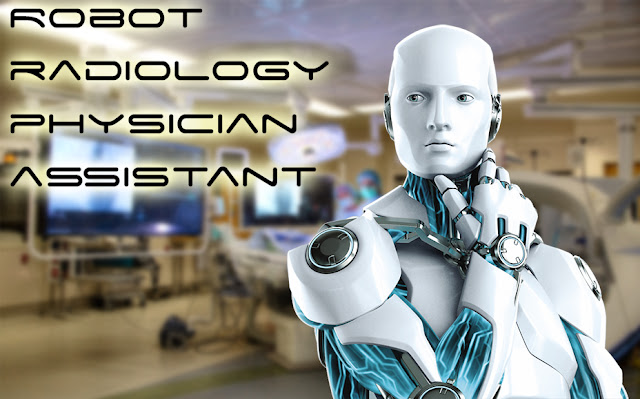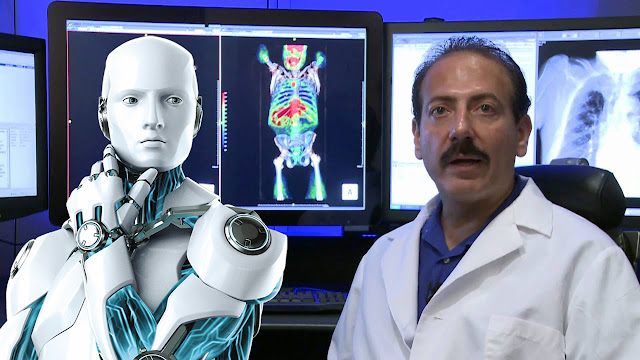As with most things in this business, technology marches on, and we see progress of a sort we could not even imagine a few years ago. I am proud to announce today that thanks to a consortium of industry and intellectual powerhouses, including IBM, Facebook, the University of Maryland, the ACR, Johns Hopkins University, US Robotics, Harvard University, and the Sirius Cybernetics Corporation, we now have the next step in the evolution of our profession, The Robot Radiology Physician Assistant:
It was only a matter of time until technology caught up to our needs, and here you see it in the flesh, er, silicon. We needed a non-threatening piece of machinery that could at once process images and help with those mundane radiological chores such as slinging barium, sticking needles, and shoving catheters. The Robot Radiology Physician Assistant, affectionately known as Rad-PAss, is the embodiment of these needs, a jack-of-all trades, of whom WE are the master.
Rad-PAss's training is second to none, having been fed the entire body of radiological literature, textbooks, journals, videos of CME meetings in Hawaii, and even the dozen or so remaining pieces of film that have not yet been rendered down for their silver content. He went through "residency" with famed University of Maryland radiologist and AI guru Dr. Eliot Siegel, which took Rad-PAss about an hour. After this, Dr. Siegel certified his performance, also noting that he was much more personable than many human residents.
Rad-PAss can be deployed in multiple configurations. Here, we see him set to interface with the latest edition of GE's Universal Viewer PACS. With some luck, it will remain operational for the 3 milliseconds Rad-PAss requires to analyze today's workload. He will then assign preliminary reports to be reviewed and corrected if necessary by the radiologist. (So far, Rad-PAss has made no errors in interpretation, but we never say "never" in this business.) The robot can be loaded with any and all of the latest AI algorithms, which he will self-evaluate delete those he finds unsuitable or beneath his dignity.
Of course, the most exciting possibilities presented by the Rad-PAss technology are to be found in the realms of fluoroscopy. Imagine turning over the drudgery of barium studies to an assistant that does not have to worry about radiation exposure! The modified delivery apparatus includes pressure sensors to optimize patient comfort, ummmmm, well, minimize discomfort.
And for the IR guys, how about a catheter-jockey assistant that can pounce on a bleeder faster than you can? Here ya go:
Suffice it to say, a brave new world dawns TODAY in Radiology. Do mark this date down in history!
Legal disclaimer: Robot images courtesy of ESET.com. Neither Dr. Siegel nor any of the institutions mentioned above have anything to do with this, or me, and are included here solely in a fictional manner. And if you didn't already realize that, you haven't checked the date of this entry.






1 comment :
Happy April Fool's Day!
Post a Comment